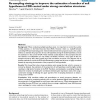Free Online Productivity Tools
i2Speak
i2Symbol
i2OCR
iTex2Img
iWeb2Print
iWeb2Shot
i2Type
iPdf2Split
iPdf2Merge
i2Bopomofo
i2Arabic
i2Style
i2Image
i2PDF
iLatex2Rtf
Sci2ools
BMCBI
2007
2007
Re-sampling strategy to improve the estimation of number of null hypotheses in FDR control under strong correlation structures
Background: When conducting multiple hypothesis tests, it is important to control the number of false positives, or the False Discovery Rate (FDR). However, there is a tradeoff between controlling FDR and maximizing power. Several methods have been proposed, such as the q-value method, to estimate the proportion of true null hypothesis among the tested hypotheses, and use this estimation in the control of FDR. These methods usually depend on the assumption that the test statistics are independent (or only weakly correlated). However, many types of data, for example microarray data, often contain large scale correlation structures. Our objective was to develop methods to control the FDR while maintaining a greater level of power in highly correlated datasets by improving the estimation of the proportion of null hypotheses. Results: We showed that when strong correlation exists among the data, which is common in microarray datasets, the estimation of the proportion of null hypotheses co...
| Added | 08 Dec 2010 |
| Updated | 08 Dec 2010 |
| Type | Journal |
| Year | 2007 |
| Where | BMCBI |
| Authors | Xin Lu, David L. Perkins |
Comments (0)

